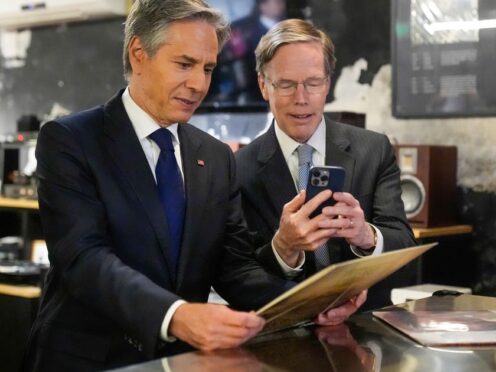US Secretary of State Antony Blinken concluded his latest visit to China with a stop at a Beijing record store where he bought albums by Taylor Swift and Chinese rocker Dou Wei in a symbolic nod to cross-cultural exchanges he had been promoting for three days.
Music, he said at the Li-Pi shop on his way to the airport late on Friday, “is the best connector, regardless of geography”.
Yet Swift’s Midnights and Dou Wei’s Black Dream could just as easily represent the seemingly intractable divisions in the deeply troubled relationship between the world’s two largest economies that both sides publicly and privately blame on the other.
Mr Blinken and his Chinese hosts, including Chinese President Xi Jinping and Foreign Minister Wang Yi, all referred to these rifts even as they extolled the virtues of keeping communication channels open to manage these differences and avoid misunderstandings and miscalculations.
Mr Blinken went out of his way to champion the importance of US-China exchanges at all levels. In Shanghai, he ate at a famous soup dumpling restaurant, attended a Chinese basketball playoff game and visited American and Chinese students at the New York University branch.
In his official meetings with Chinese leaders in Beijing, he spoke repeatedly of improvements in ties over the past year.
But he also stressed that the US has serious and growing concerns with China’s policies and practices on the local, regional and global stages. And, he said, the US would not back down.
“America will always defend our core interests and values,” he said.
On several occasions, he criticised Chinese overproduction of electric vehicles that threatened to have detrimental effects on US and European automakers and complained that China was not doing enough to stop the production and export of synthetic opioid precursors.
At one point he warned bluntly that if China does not end support for Russia’s defence industrial sector, something the Biden administration says has allowed Russia to step up its attacks on Ukraine and threaten European security, the US would act to stop it.
“I made clear that if China does not address this problem, we will,” Mr Blinken told reporters after meeting with Mr Xi.
Chinese officials were similarly direct, saying that while relations have generally improved since a low point last year over the shootdown of a Chinese surveillance balloon, they remained fraught.
“The two countries should help each other succeed rather than hurt each other, seek common ground and reserve differences rather than engage in vicious competition, and honour words with actions rather than say one thing but do the opposite,” Mr Xi told Mr Blinken.

Mr Wang, the foreign minister, said China is fed up with what it considers to be US meddling in human rights, Taiwan and the South China Sea and efforts to restrict its trade and relations with other countries.
“Negative factors in the relationship are still increasing and building and the relationship is facing all kinds of disruptions,” he said.
He urged the US “not to step on China’s red lines on China’s sovereignty, security, and development interests”.
Or, as Yang Tao, the director general of North American and Oceania affairs at the Foreign Ministry, put it, according to the official Xinhua News Agency: “If the United States always regards China as its main rival, China-US relations will continuously face troubles and many problems.”
Still, Mr Blinken pressed engagement on all levels. He announced a new agreement to hold talks with China on the threats posed by artificial intelligence but lamented a dearth of American students studying in China – fewer than 900 now, compared with more than 290,000 Chinese in the US. He said both sides wanted to increase that number.
“We have an interest in this, because if our future leaders – whether it’s in government, whether it’s in business, civil society, climate, tech, and other fields – if they’re going to be able to collaborate, if they want to be able to solve big problems, if they’re going to be able to work through our differences, they’ll need to know and understand each other’s language, culture, history,” he said.
“What I told my PRC counterparts on this visit is if they want to attract more Americans here to China, particularly students, the best way to do that is to create the conditions that allow learning to flourish anywhere – a free and open discussion of ideas, access to a wide range of information, ease of travel, confidence in the safety, security and privacy of the participants,” Mr Blinken said.
